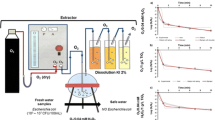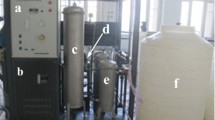Abstract
The aim of this study was to explain by molecular pathways the kinetic differences between reuse water disinfection processes using UV-C radiation and OH• radicals. The Fenton reaction (which produces OH radicals) was found to be significantly more effective at inactivating of thermotolerant coliforms (TTC) than either H2O2/UV-C or direct UV-C, with constants of inactivation that were some 6- to 14-fold higher. The superiority of Fenton was attributed to the powerful action of OH• in disassembling the molecular structure of E. coli cell wall and inducing the collapse of the entire cell structure, as demonstrated via molecular mechanisms. Under optimized conditions, treatment of wastewater in a plant comprising an anaerobic hybrid reactor with intermittent sand filter followed by a Fenton process led to the removal of 97.2% TOC, 99.9% turbidity and 100% of TTC and the quality of the final effluent was appropriate for direct potable reuse.






Similar content being viewed by others
References
Aguayo D, Pacheco N, Morales EH, Collao B, Luraschi R, Cabezas C, Calderón P, González-Nilo F, Gil F, Calderón IL, Saavedra CP (2015) Hydrogen peroxide and hypochlorous acid influx through the major S. typhimurium porin OmpD is affected by substitution of key residues of the channel. Arch Biochem Biophys 568:38–45. https://doi.org/10.1016/j.abb.2015.01.005
Alupoaei CE, García-Rubio LH (2004) Growth behavior of microorganisms using UV-Vis spectroscopy: Escherichia coli. Biotechnol Bioeng 86:163–167. https://doi.org/10.1002/bit.20001
Alvarez BL, Guzman PV, Peñuela GA, Palma RAT (2016) Degradation of a toxic mixture of the pesticides carbofuran and iprodione by UV-C/H2O2: evaluation of parameters and implications of the degradation pathways on the synergistic effects. Water Air Soil Pollution 23:215–227. https://doi.org/10.1007/s11270-016-2903-2
Angthararuk D, Harir M, Schmitt-Kopplin P, Sutthivaiyakit S, Kettrup A, Sutthivaiyakit P (2017) Degradation products of profenofos as identified by high-field FTICR mass spectrometry: Isotopic fine structure approach. J Environ Sci Health 52:10–22. https://doi.org/10.1080/03601234.2016.1224696
Armanious A, Münch M, Kohn T, Sander M (2016) Competitive coadsorption dynamics of viruses and dissolved organic matter to positively charged sorbent surfaces. Environ Sci Technol 50:3597–3606. https://doi.org/10.1021/acs.est.5b05726
Association APH (2012) Standard methods for the examination of water and wastewater, 22nd edn. APHA, New York
Babu M, Bundalovic-Torma C, Calmettes C, Phanse S, Zhang Q, Jiang Y, Minic Z, Kim S, Mehla J, Gagarinova A, Rodionova I, Kumar A, Guo H, Kagan O, Pogoutse O, Aoki H, Deineko V, Caufield JH, Holtzapple E, Zhang Z, Vastermark A, Pandya Y, Lai CC-L, El Bakkouri M, Hooda Y, Shah M, Burnside D, Hooshyar M, Vlasblom J, Rajagopala SV, Golshani A, Wuchty S, Greenblatt JF, Saier M, Uetz P, Moraes TF, Parkinson J, Emili A (2018) Global landscape of cell envelope protein complexes in Escherichia coli. Nat Biotechnol 36:103–112. https://doi.org/10.1038/nbt.4024
Boucenna A, Oturan N, Chabani M, Bouafia-Chergui S, Oturan MA (2019) Degradation of nystatin in aqueous medium by coupling UV-C irradiation, H2O2 photolysis, and photo-Fenton processes. Environ Sci Pollut Res Int 26:23149–23161. https://doi.org/10.1007/s11356-019-05530-2
Bruguera-Casamada, C., Araujo-Boira, R.M., Brillas, E., Sirés Sardonil, I., 2018. Advantages of electro-Fenton over electrocoagulation for disinfection of dairy wastewater. Chem. Eng. J. 376, 119975. https://doi.org/10.1016/j.cej.2018.09.136
Chick H (1908) Investigations of the laws of disinfection. J Hyg 8:92–158. https://doi.org/10.1017/s0022172400006987
Crini G, Lichtfouse E (2019) Advantages and disadvantages of techniques used for wastewater treatment. Environ Chem Lett 17:145–155. https://doi.org/10.1007/s10311-018-0785-9
Cruz M, Gomez C, Duran-Valle CJ, Pastrana-Martínez LM, Faria JL, Silva AMT, Faraldos M, Bahamonde A (2017) Bare TiO2 and graphene oxide TiO2 photocatalysts on the degradation of selected pesticides and influence of the water matrix. Appl Surf Sci 416:1013–1021. https://doi.org/10.1016/j.apsusc.2015.09.268
Diak J, Örmeci B (2017) Ferrate(VI) and freeze-thaw treatment for oxidation of hormones and inactivation of fecal coliforms in sludge. Water Sci Technol 75:1625–1632. https://doi.org/10.2166/wst.2017.021
Díaz-Mejía JJ, Babu M, Emili A (2009) Computational and experimental approaches to chart the Escherichia coli cell-envelope-associated proteome and interactome. FEMS Microbiol Rev 33:66–97. https://doi.org/10.1111/j.1574-6976.2008.00141.x
Gaber A (2014) The importance of Arabidopsis glutathione peroxidase 8 for protecting Arabidopsis plant and E. coli cells against oxidative stress. GM Crops Food 5:20–26. https://doi.org/10.4161/gmcr.26979
Giannakis S (2018) Analogies and differences among bacterial and viral disinfection by the photo-Fenton process at neutral pH: a mini review. Environ Sci Pollut Res 25:27676–27692. https://doi.org/10.1007/s11356-017-0926-x
Giannakis S, Ruales-Lonfat C, Rtimi S, Thabet S, Cotton P, Pulgarin C (2016) Castles fall from inside: evidence for dominant internal photo-catalytic mechanisms during treatment of Saccharomyces cerevisiae by photo-Fenton at near-neutral pH. Appl Catal B Environ 185:150–162. https://doi.org/10.1016/j.apcatb.2015.12.016
Giannakis S, Liu S, Carratalà A, Rtimi S, Bensimon M, Pulgarin C (2017) Effect of Fe (II)/Fe (III) species, pH, irradiance and bacterial presence on viral inactivation in wastewater by the photo-Fenton process: kinetic modeling and mechanistic interpretation. Appl Catal B Environ 204:156–166. https://doi.org/10.1016/j.apcatb.2016.11.034
Gidden J, Denson J, Liyanage R, Ivey DM, Lay JO (2009) Lipid compositions in Escherichia coli and Bacillus subtilis during growth as determined by MALDI-TOF and TOF/TOF mass spectrometry. Int J Mass Spectrom 283:178–184. https://doi.org/10.1016/j.ijms.2009.03.005
Kiefer J, Ebel N, Schlücker E, Leipertz A (2010) Characterization of Escherichia coli suspensions using UV/Vis/NIR absorption spectroscopy. Anal Meth 2:123–128. https://doi.org/10.1039/B9AY00185A
Klein G, Raina S (2019) Regulated assembly of LPS, its structural alterations and cellular response to LPS defects. Int J Mol Sci 20:356. https://doi.org/10.3390/ijms20020356
Li H, Li Y, Xiang L, Huang Q, Qiu J, Zhang H, Sivaiah MV, Baron F, Barrault J, Petit S, Valange S (2015) Heterogeneous photo-Fenton decolorization of orange II over Al-pillared Fe-smectite: Response surface approach, degradation pathway, and toxicity. J Hazard Mater 287:32–41. https://doi.org/10.1016/j.jhazmat.2015.01.023
Luna YHDM, Lopes WS, Sousa JT, Lopes WS (2019) Caracterização de lodo anaeróbio produzido em reatores de manta de lodo de baixo tempo de retenção sólidos. Rev DAE 67(24–34):2019. https://doi.org/10.4322/dae.2019.030
Malvestiti JA, Dantas RF (2018) Disinfection of secondary effluents by O3, O3/H 2O2 and UV/H2O2: Influence of carbonate, nitrate, industrial contaminants and regrowth. J Environ Chem Eng 6:560–567. https://doi.org/10.1016/j.jece.2017.12.058
Menager M, Pilichowski JF, Sarakha M (2010) Reaction pathways for the photodegradation of the organophosphorus cyanophos in aqueous solutions. Photochem Photobiol 86:247–254. https://doi.org/10.1111/j.1751-1097.2009.00654.x
Moriarty MJ, Semmens K, Bissonnette GK, Jaczynski J (2018) Inactivation with UV-radiation and internalization assessment of coliforms and Escherichia coli in aquaponically grown lettuce. LWT Food Sci Technol 89(624–630):2018. https://doi.org/10.1016/j.lwt.2017.11.038
Müller WEG, Link T, Li Q, Schröder HC, Batel R, Blažina M, Grebenjuk VA, Wang X (2014) A novel TiO2-assisted magnetic nanoparticle separator for treatment and inactivation of bacterial contaminants in aquatic systems. RSC Adv 4:48267–48275. https://doi.org/10.1039/c4ra09055a
Orench-Rivera N, Kuehn M (2019) Oxidative stress-induced protein packaging in enterotoxigenic Escherichia coli outer membrane vesicles and its functional impact on host-pathogen interactions. FASEB J 33 (S1):649.10–649.10. https://doi.org/10.1096/fasebj.2019.33.1_supplement.649.10
Ortega-Gómez E, Martín MMB, Carratalà A, Ibañez PF, Sánchez Pérez JA, Pulgarín C (2015) Principal parameters affecting virus inactivation by the solar photo-Fenton process at neutral pH and μM concentrations of H2O2 and Fe2+/3+. Appl Catal B Environ 175:395–402. https://doi.org/10.1016/j.apcatb.2015.03.016
Palma-Goyes RE, Silva-Agredo J, González I, Torres-Palma RA (2014) Comparative degradation of indigo carmine by electrochemical oxidation and advanced oxidation processes. Electrochim Acta 140:427–433. https://doi.org/10.1016/j.electacta.2014.06.096
Paranychianakis NV, Salgot M, Snyder SA, Angelakis AN (2014) Water reuse in EU States: necessity for uniform criteria to mitigate human and environmental risks. Crit Rev Environ Sci Technol 45:1409–1468. https://doi.org/10.1080/10643389.2014.955629
Pignatello JJ, Oliveros E, MacKay A (2006) Advanced oxidation processes for organic contaminant destruction based on the Fenton reaction and related chemistry. Crit Rev Environ Sci Technol 36:1–84. https://doi.org/10.1080/10643380500326564
Răducan A, Puiu M, Oancea P, Colbea C, Velea A, Dinu B, Mihăilescua AM, Galaon T (2019) Fast decolourization of indigo carmine and crystal violet in aqueous environments through micellar catalysis. Sep Purif Technol 210:698–709. https://doi.org/10.1016/j.seppur.2018.08.052
Rodríguez-Chueca J, Mosteo R, Ormad MP, Ovelleiro JL (2012) Factorial experimental design applied to Escherichia coli disinfection by Fenton and photo-Fenton processes. Solar Energ 86:3260–3267. https://doi.org/10.1016/j.solener.2012.08.015
Rubio-Clemente A, Chica E, Peñuela G (2018) Total coliform inactivation in natural water by UV/H2O2, UV/US, and UV/US/H2O2 systems. Environ Sci Pollut Res 26:4462–4473. https://doi.org/10.1007/s11356-018-3297-z
Salgot M, Folch M (2018) Wastewater treatment and water reuse. Curr Opin Environ Sci Health 2:64–74. https://doi.org/10.1016/j.coesh.2018.03.005
Schmidt A, Kochanowski K, Vedelaar S, Ahrné E, Volkmer B, Callipo L, Knoops K, Bauer M, Aebersold R, Heinemann M (2015) The quantitative and condition-dependent Escherichia coli proteome. Nat Biotechnol 34:104–110. https://doi.org/10.1038/nbt.3418
Sousa JT, Lima JF, Silva VC, Leite VD, Lopes WS (2017) Recovery of elemental sulphur from anaerobic effluents through the biological oxidation of sulphides. Environ Technol 38:529–537. https://doi.org/10.1080/09593330.2016.1201148
Teel AL, Watts RJ (2017) Effect of wastewater quality parameters on coliform inactivation by tin oxide anodes. J Environ Sci Health Part A 53:443–447. https://doi.org/10.1080/10934529.2017.1409020
Torres-Blancas T, Roa-Morales G, Barrera-Díaz C, Ureña-Nuñez F, Cruz-Olivares J, Balderas-Hernandez P, Natividad R (2015) Ozonation of indigo carmine enhanced by Fe/Pimenta dioica L. Merrill particles. Int J Photoenergy. Article ID 608412. https://doi.org/10.1155/2015/608412
Tu Y, Lv M, Xiu P, Huynh T, Zhang M, Castelli M, Liu Z, Huang Q, Fan C, Fang H, Zhou R (2013) Destructive extraction of phospholipids from Escherichia coli membranes by graphene nanosheets. Nat Nanotechnol 8:594–601. https://doi.org/10.1038/nnano.2013.125
U.S. Environmental Protection Agency, 2012 (2012) Guidelines for Water Reuse. EPA, Washington. https://www.epa.gov/sites/production/files/2019-08/documents/2012-guidelines-water-reuse.pdf (Accessed on 25 July 2020)
U.S. Environmental Protection Agency, 2017 (2017) Potable Reuse Compendium. EPA, Washington. https://www.epa.gov/sites/production/files/2018-01/documents/potablereusecompendium_3.pdf (accessed on 25 July 2020)
Vargas GDLP, Moreira RFPM, Spricigo D, José HJ (2013) Treated domestic sewage: kinetics of Escherichia coli and total coliform inactivation by oxidation with hydrogen peroxide. Quím Nova 36:252–256. https://doi.org/10.1590/S0100-40422013000200009
Wolf AJ, Underhill DM (2018) Peptidoglycan recognition by the innate immune system. Nat Rev Immunol 18(4):243–254. https://doi.org/10.1038/nri.2017.136
Zerbib D (2017) Bacterial cell envelopes: composition, architecture, and origin. In: Miklavčič D (ed) Handbook of electroporation. Springer, Cham, pp 417–436. https://doi.org/10.1007/978-3-319-32886-7_28
Acknowledgements
The authors wish to thank Conselho Nacional de Desenvolvimento Científico e Tecnológico (CNPq), Coordenação de Aperfeiçoamento de Pessoal de Nível Superior (CAPES) and Financiadora de Estudos e Projetos (FINEP) for financial support.
Author information
Authors and Affiliations
Contributions
ROR involved in conceptualization/data curation/software. WSL took part in formal analysis. YHDML took part in formal analysis. MVCA contributed to formal analysis. VDL involved in conceptualization/review. JTS involved in supervision/review. AMCU contributed to review & editing. WSL took part in project administration/review & editing.
Corresponding author
Ethics declarations
Conflict of interest
The authors declare no competing interests, financial or otherwise that could have influenced the work reported in this paper.
Additional information
Editorial responsibility: Samareh Mirkia.
Supplementary Information
Below is the link to the electronic supplementary material.
Rights and permissions
Springer Nature or its licensor (e.g. a society or other partner) holds exclusive rights to this article under a publishing agreement with the author(s) or other rightsholder(s); author self-archiving of the accepted manuscript version of this article is solely governed by the terms of such publishing agreement and applicable law.
About this article
Cite this article
Ramos, R.O., Lopes, W.S., Luna, Y.H.D.M. et al. Treatment of wastewater for reuse using advanced oxidation process: a bacterial inactivation mechanism approach. Int. J. Environ. Sci. Technol. 20, 11275–11286 (2023). https://doi.org/10.1007/s13762-022-04732-5
Received:
Revised:
Accepted:
Published:
Issue Date:
DOI: https://doi.org/10.1007/s13762-022-04732-5




